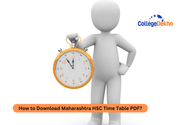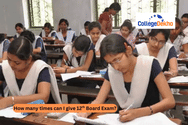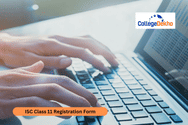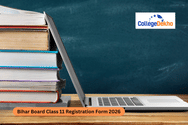

Never Miss an Exam Update
ISC Class 12 Computer Science Syllabus 2025-26 has been released by the Council for the Indian School Certificate Examinations (CISCE) online. You can download the curriculum PDF online at cisce.org. A total of 14 chapters are included in the curriculum according to the latest curriculum PDF released online. The theory paper will be conducted for 70 marks, and 30 marks will be provided for the practical exam. Some chapters included in the syllabus are computer systems, artificial intelligence, database systems, data structures, programming languages, bioinformatics, algorithms, and so on. Do not forget to also go through the ISC Class 12 Computer Science Exam Pattern 2025-26 to enhance your preparations.
You can also go through the ISC Class 12 Computer Science Specimen Paper 2025-26 for practice. Make sure to learn the syllabus in detail to get good marks in the exam. Check out the complete ISC Class 12 Computer Science Syllabus 2025-26 below:
Download ISC Class 12 Computer Science Previous Year Question Paper
ISC Class 12 Computer Science Syllabus 2025-26
Learning the curriculum is the first step towards preparing for any type of paper. Since Computer Science mostly requires coding, make sure to start preparing soon, and do not forget to work on practicals also. Make sure to complete the theory portion first so that you can focus more on coding and the practical aspect of the syllabus. Check out the detailed ISC Class 12 Computer Science Syllabus 2025-26 below:
Section | Topics |
|---|---|
Section A | 1. Boolean Algebra (a) Propositional logic, well formed formulae, truth values and interpretation of well formed formulae (wff), truth tables, satisfiable, unsatisfiable and valid formulae. Equivalence laws and their use in simplifying wffs. Propositional variables: the common logical connectives (~ (not)(negation), ∧ (and)(conjunction), ∨ (or)(disjunction), ⇒ (implication), ⇔ (biconditional); definition of a well-formed formula (wff); `representation of simple word problems as wff (this can be used for motivation); the values true and false; interpretation of a wff; truth tables; satisfiable, unsatisfiable and valid formulae. Equivalence laws: commutativity of ∧, ∨; associativity of ∧, ∨; distributivity; De Morgan’s laws; law of implication (p ⇒ q ≡ ~p ∨ q); law of biconditional ((p ⇔ q) ≡ (p ⇒ q) ∧ (q ⇒ p)); identity (p ≡ p); law of negation (~ (~p) ≡ p); law of excluded middle (p ∨~p ≡ true); law of contradiction (p∧~p ≡ false); tautology and contingency simplification rules for ∧, ∨. Converse, inverse and contra positive. (b) Binary valued quantities; basic postulates of Boolean algebra; operations AND, OR and NOT; truth tables. (c) Basic theorems of Boolean algebra (e.g. duality, idempotence, commutativity, associativity, distributivity, operations with 0 and 1, complements, absorption, involution); De Morgan’s theorem and its applications; reducing Boolean expressions to sum of products and product of sums forms; Karnaugh maps (up to four variables). Verify the laws of Boolean algebra using truth tables. Inputs, outputs for circuits like half and full adders, majority circuit etc., SOP and POS representation; Maxterms & Minterms, Canonical and Cardinal representation, reduction using Karnaugh maps and Boolean algebra. 2. Computer Hardware (a) Elementary logic gates (NOT, AND, OR, NAND, NOR, XOR, XNOR) and their use in circuits. (b) Applications of Boolean algebra and logic gates to half adders, full adders, encoders, decoders, multiplexers, NAND, NOR as universal gates. Show the correspondence between Boolean methods and the corresponding switching circuits or gates. Show that NAND and NOR gates are universal by converting some circuits to purely NAND or NOR gates. |
Section B | The programming element in the syllabus (Sections B and C) is aimed at algorithmic problem solving and not merely rote learning of Java syntax. The Java version used should be 5.0 or later. For programming, the students can use any text editor and the javac and java programs or any other development environment: for example, BlueJ, Eclipse, NetBeans etc. BlueJ is strongly recommended for its simplicity, ease of use and because it is very well suited for an ‘objects first’ approach. 3. Implementation of algorithms to solve problems The students are required to do lab assignments in the computer lab concurrently with the lectures. Programming assignments should be done such that each major topic is covered in at least one assignment. Assignment problems should be designed so that they are sufficiently challenging. Students must do algorithm design, address correctness issues, implement and execute the algorithm in Java and debug where necessary. Self explanatory. 4. Programming in Java (Review of Class XI Sections B and C) Note that items 4 to 13 should be introduced almost simultaneously along with classes and their definitions. While reviewing, ensure that new higher order problems are solved using these constructs. 5. Objects (a) Objects as data (attributes) + behaviour (methods); object as an instance of a class. Constructors. (b) Analysis of some real-world programming examples in terms of objects and classes. (c) Basic input/output using Scanner from JDK; input/output exceptions. Tokens in an input stream, concept of whitespace. 6. Primitive values, Wrapper classes, Types and casting Primitive values and types: byte, int, short, long, float, double, boolean, char. Corresponding wrapper classes for each primitive type. Class as type of the object. Class as mechanism for user defined types. Changing types through user defined casting and automatic type coercion for some primitive types. 7. Variables, Expressions Variables as names for values; named constants (final), expressions (arithmetic and logical) and their evaluation (operators, associativity, precedence). Assignment operation; difference between left hand side and right hand side of assignment. 8. Statements, Scope Statements; conditional (if, if else, if else if, switch case, ternary operator), looping (for, while, do while, continue, break); grouping statements in blocks, scope and visibility of variables. 9. Methods Methods (as abstractions for complex user defined operations on objects), formal arguments and actual arguments in methods; Static method and variables. The this Operator. Examples of algorithmic problem solving using methods (number problems, finding roots of algebraic equations etc.). 10. Arrays, Strings Structured data types – arrays (single and multidimensional), address calculations, strings. Example algorithms that use structured data types (e.g. searching, finding maximum/minimum, sorting techniques, solving systems of linear equations, substring, concatenation, length, access to char in string, etc.). Storing many data elements of the same type requires structured data types – like arrays. Access in arrays is constant time and does not depend on the number of elements. Address calculation (row major and column major), Sorting techniques (bubble, selection, insertion). Structured data types can be defined by classes – String. Introduce the Java library String class and the basic operations on strings (accessing individual characters, various substring operations, concatenation, replacement, index of operations). 11. Recursion Concept of recursion, simple recursive methods (e.g. factorial, GCD, binary search, conversion of representations of numbers between different bases). Many problems can be solved very elegantly by observing that the solution can be composed of solutions to ‘smaller’ versions of the same problem with the base version having a known simple solution. Recursion can be initially motivated by using recursive equations to define certain methods. These definitions are fairly obvious and are easy to understand. The definitions can be directly converted to a program. Emphasize that any recursion must have a base case. Otherwise, the computation can go into an infinite loop. The tower of Hanoi is a very good example of how recursion gives a very simple and elegant solution where as non-recursive solutions are quite complex. |
Section C Inheritance, Interface, Polymorphism, Data structures, Computational complexity | 12. Inheritance, Interfaces and Polymorphism (a) Inheritance; super and derived classes; member access in derived classes; redefinition of variables and methods in subclasses; abstract classes; class Object; protected visibility. Subclass polymorphism and dynamic binding. Emphasize inheritance as a mechanism to reuse a class by extending it. Inheritance should not normally be used just to reuse some methods defined in a class but only when there is a genuine specialization (or subclass) relationship between objects of the super class and that of the derived class. (b) Interfaces in Java (Conceptual) Emphasize the difference between the Java language construct interface and the word interface often used to describe the set of method prototypes of a class. 13. Data structures (a) Basic data structures (stack, linear queue); implementation directly through classes. Conversion of Infix to Prefix and Postfix notations. Basic algorithms and programs using the above data structures. (b) Binary trees, tree traversals (Conceptual). The following should be covered: Binary trees- apart from the definition the following concepts should be covered: root, internal nodes, external nodes (leaves), height (tree, node), depth (tree, node), level, size, degree, siblings, sub tree, completeness, balancing, traversals (pre, post and in-order). 14. Complexity (Conceptual) Concept of complexity; input size; importance of dominant term; constants, best, average and worst case |
How To Download ISC Class 12 Computer Science Syllabus 2025-26?
The PDF of the ISC Class 12 Computer Science Syllabus 2025-26 has been uploaded on the official website of CISCE. You can follow the simple procedure given below to download the syllabus PDF from the official website easily:
- Step 1: Visit the official website of the Council for the Indian School Certificate Examinations at cisce.org.
- Step 2: The homepage will open on your screen, where you have to click on the option called Examinations present on the menu bar and then click on ISC Examinations from the drop-down menu.
- Step 3: Now, click on Regulations and Syllabuses.
- Step 4: The syllabus for the different years will open on your screen. Click on Regulations and Syllabuses – ISC 2026. You can now download the syllabus for Computer Science.
ISC Class 12 Computer Science Syllabus 2025-26 PDF
You can download the latest PDF of the ISC Class 12 Computer Science Syllabus 2025-26 by clicking on the direct links given below:
Focus on completing the syllabus as soon as possible so that you can shift your focus to the sample question papers for an effective revision session during the last months of the preparations. Also, understand the ISC Class 12 Computer Science Weightage 2026 for more thorough preparation.
Are you feeling lost and unsure about what career path to take after completing 12th standard?
Say goodbye to confusion and hello to a bright future!

FAQs
You can revise the ISC Class 12 Computer Science Syllabus 2025-26 by using specimen question papers uploaded on the official website of CISCE. You can also download previous years' question papers and question banks available online for revision.
To complete the ISC Class 12 Computer Science Syllabus 2025-26, you need at least 5 to 6 months and 1 to 2 months to revise the syllabus.
There are no major changes made to the ISC Class 12 Computer Science Syllabus 2025-26, but you are required to download the latest syllabus to check out the minor changes made to the topics included in each chapter and read the syllabus carefully.
Yes, the ISC Class 12 Computer Science Syllabus 2025-26 has been released. You can check the PDF of the syllabus by visiting the official website of CISCE at cisce.org.
As per the ISC Class 12 Computer Science Syllabus 2025-26, Data Structures includes the following topics: Basic data structures (stack, queue, circular queue, dequeue); implementation directly through classes; definition through an interface and multiple implementations by implementing the interface. Conversion of Infix to Prefix and Postfix notations, Single linked list (Algorithm and programming), binary trees, tree traversals (Conceptual).
Was this article helpful?




















